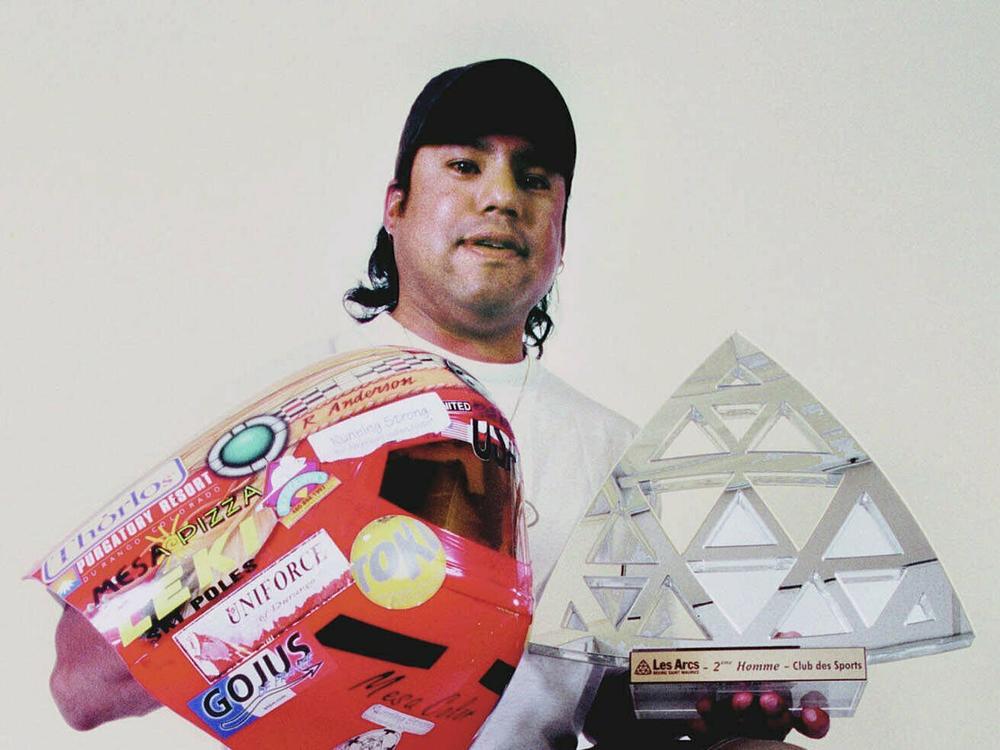Section Branding
Header Content
Indigenous trailblazer to be inducted into Ski and Snowboard Hall of Fame
Primary Content
Since 2006, Ross Anderson has held the record for going faster than any other American on skis: 154.06 mph. And this year, he's finally receiving some recognition from his peers in pro skiing.
As he walked into a resort ballroom in Park City to be inducted into the US Ski and Snowboard Hall of Fame, a Lakota prayer song played over the ballroom sound system. At the end of his acceptance speech, Anderson held an eagle feather over his own head and gazed at the audience. Onlookers gave him a standing ovation.
"I've been planning to do those things for a long time," said Anderson. "I want people to know that you need to be proud of who you are. No matter who you are."
His induction into the US Ski and Snowboard Hall of Fame makes him the first outwardly presenting Native American to receive that honor.
His induction into the US Ski and Snowboard Hall of Fame makes him the first outwardly presenting Native American to receive that honor.
As an indigenous athlete and person of color, Anderson was a trailblazer in professional skiing. When he was a boy growing up in Durango, Colorado, professional racers were exclusively Caucasian. Anderson was at ease among a community full of extreme athletes and more than a few Olympians, and by the time he was ten years old, he knew from the comments of coaches and local parents that he was a gifted skier.
"I had rhythm," he said. "I wasn't afraid to make a line that goes vertical all the way down the mountain, and I lived to go fast."
But Anderson struggled with his own racial identity. Anderson's heritage is Cheyenne-Arapaho and Mescalero Apache, but he was adopted by white parents when he was a newborn.
"As a teenager it was difficult," Anderson recalled. "Getting teased because you're darker than the other people, and the worst of the worst was using sandpaper or pumice stone on skin to make it lighter. I did that a few times."
It wasn't until high school that Anderson began to learn about indigenous culture. He also learned how to transform his sense of anger and alienation into a competitive edge. In his late teens, Anderson had a vision of himself breaking racial barriers as a World Cup ski racer.
"I didn't know what category of skiing it was going to be," he said. "I decided I'm just going to do it, because there's nobody of color. Just as long as I'm able to be in the World Cup, I think I'll make a difference."
Anderson got encouragement and pointers from a pro speed skier based in Durango. Within a few years, he was competing internationally, wearing a red helmet airbrushed with a headdress of yellow feathers.
In 2006, at a race in the French Alps, he clocked 154.06 miles per hour, a record no American has broken.
Speed skiing is all about velocity
It's hard to imagine going 150 miles an hour on skis, and the few video clips of Ross Anderson online don't help much. But a few videos offer a sense of what it's like to be next to a racecourse when a speed skier goes rocketing past, like this footage of Italian speed skier Simone Origone.
Standing next to a speed skiing course, "the wind sounds so intense, like a jet," Anderson said. "But the ground close to the track kind of vibrates a little bit too."
Competitive speed skiers aim for maximum velocity. There are no points for technique, there's no sharp turning. The fastest time wins the race. Skiers go straight down a steep incline that runs about a mile, wearing rubber suits and helmets that come down to their shoulders to minimize wind resistance.
This video captures the point of view of a speed skier.
"You're about a foot and a half off the ground because you're in a full-on tuck," said Anderson. "You're only seeing 20 feet in front of you."
A run lasts less than half a minute, but when things are going well, time slows down.
Inside that realm of extreme focus and concentration, a speed skier can make slight adjustments to body positioning if there's any wind resistance.
"If you have any air that sounds louder than normal, then you can fix it, said Anderson. "You can hear the wind calm down a little."
Inspiring more Indigenous athletes to ski and snowboard
As a teenager, Ross Anderson set out to inspire people of color to become competitive skiers. For at least one Native Alaskan girl growing up in a remote fishing village, it worked.
"I viscerally remember seeing his headdress and the feathers on his helmet," recalled Callan Chythlook-Sifsof, a Yupik and Inupiaq snowboarder who competed in World Cup snowboarding for a decade and represented the US in the 2010 Winter Olympics.
"Truly there are no role models in that echelon of skiing and snowboarding to be found that are indigenous or outwardly-presenting indigenous," she said. "Looking back, Ross Anderson was everything to me."
The success of Anderson and Chythlook-Sifsof has yet to bring many indigenous athletes to professional skiing and snowboarding– these sports remain the provinces of white athletes, white coaches, and white leaders. Critics say structural changes are needed inside the sport, from team culture to organizational leadership.
But Ross Anderson vows to use his hall of fame status to continue the work of encouraging Native Americans to explore skiing and snowboarding, and he wants to push ski resorts to establish stronger relationships with Native American tribes.
"It's not over," he said. "That's the cool thing about it–this vision's still going."

